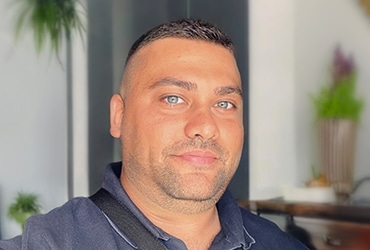A One up in the Battle against Multiple Myeloma
Despite the surge in new treatments, multiple myeloma remains stubbornly incurable. Patients typically respond to their first treatment for about two years, but subsequent therapies often provide diminishing relief due to overlapping mechanisms of action (1). This underscores the urgent need for novel therapeutic strategies, rather than just variations of existing ones.
With the support of the 2019 AACR-Takeda Oncology Myeloma Research Fellowship, Amin Sobh, PhD, identified adenylate kinase 2 (AK2) as a promising target, particularly for multiple myeloma patients with the t(4;14) chromosomal translocation (2). Dr. Sobh highlighted: “The study revealed a novel paradigm illustrating the complex interplay between epigenetic dysregulation and cellular metabolism in cancer, operating through mechanisms that do not rely on direct gene expression regulation.”

The t(4:14) chromosomal translocation, present in a subset of multiple myeloma patients, involves a translocation event between chromosome 4 (NSD2 gene) and chromosome 14 (IgH locus). This event leads to the overexpression of the histone methyltransferase NSD2, eventually resulting in tumorigenesis and drug resistance (3). Inhibiting NSD2 directly in the clinic, however, has not been successful.
Supported by his AACR grant, Dr. Sobh sought to identify novel vulnerabilities in NSD2-overexpressing multiple myeloma (MM). Through CRISPR-based screening of isogenic cells with varying NSD2 expression, he discovered that NSD2-overexpressing cells are more dependent on metabolic processes such as oxidative phosphorylation and NADPH metabolism, particularly on AK2 activity. Analysis of patient outcomes using the Multiple Myeloma Research Foundation CoMMpass data (4) revealed that patients with higher AK2 levels, especially those with the t(4;14) translocation, had worse overall and progression-free survival. Dr. Sobh and his colleagues showed that blockade of AK2 inhibited the growth of MM cells in vitro and in vivo in an NSD2-dependent manner. Through a numerous experiments, they observed that AK2 inhibition in NSD2-overexpressing MM cells induced DNA replication stress by disrupted nucleotide metabolism. The team further demonstrated that AK2 suppression impaired protein folding in the endoplasmic reticulum (ER), rendering MM cells more sensitive to the proteasome inhibitor bortezomib.
To understand why NSD2 overexpression drives reliance of MM cells on AK2 activity, Dr. Sobh further investigated the role of NSD2 in cellular metabolism. They found that NSD2-high cells exhibited elevated levels of homocysteine, spermidine, and the creatine precursor guanidinoacetate. The authors attribute the accumulation of these metabolites to a decreased availability of S-adenosylmethionine (SAM) as a methyl donor. They proposed that NSD2 overexpression and the concomitant increase in histone methyltransferase activity diverts SAM toward genomic methylation and depletes cellular creatine. This metabolic shift likely accounts for the increased sensitivity of NSD2-overexpressing myeloma cells to AK2 inhibition, as creatine supplementation notably mitigated the DNA damage and growth suppression induced by AK2 knockdown.
Highlighting the benefits of the AACR grant, Dr. Sobh shared, “The funding I received from AACR was pivotal in shaping my research path and advancing my professional development. This grant provided essential support at the onset of my career, enabling me to pursue innovative research directions that have led to impactful findings and meaningful contributions to the field. Beyond the research itself, the AACR grant significantly enhanced my credibility and visibility within the scientific community, helping me establish a strong academic foundation and secure further career development funding.”
We invite postdoctoral fellows who are working on hematological cancers to apply for the 2024 AACR Hematologic Malignancies Research Fellowship. The deadline to apply is January 21, 2025 at 1:00PM EST. Any inquiries regarding this funding opportunity may be directed to [email protected].
References:
- Seth S, Kapoor P, Buadi F, Binder M, Cook J, Dispenzieri A, et al. First relapse in patients with multiple myeloma: Outcomes and predictors. Journal of Clinical Oncology. 2024; 42:7558. doi: 10.1200/JCO.2024.42.16_suppl.7558
- Sobh A, Encinas E, Patel A, Surapaneni G, Bonilla E, Kaestner C, et al. NSD2 drives t(4;14) myeloma cell dependence on adenylate kinase 2 by diverting one-carbon metabolism to the epigenome. Blood. 2024; 144:283-95
- Bennett RL, Swaroop A, Troche C, Licht JD. The Role of Nuclear Receptor–Binding SET Domain Family Histone Lysine Methyltransferases in Cancer. Cold Spring Harb Perspect Med. 2017; 7: a026708
- Keats JJ, Craig DW, Liang W, Venkata Y, Kurdoglu A, Aldrich J, et al. Interim Analysis Of The MMRF CoMMpass Trial, a Longitudinal Study In Multiple Myeloma Relating Clinical Outcomes To Genomic and Immunophenotypic Profiles. Blood. 2013; 122: 532
- Fujisawa K. Regulation of Adenine Nucleotide Metabolism by Adenylate Kinase Isozymes: Physiological Roles and Diseases. Int J Mol Sci. 2023; 24:5561